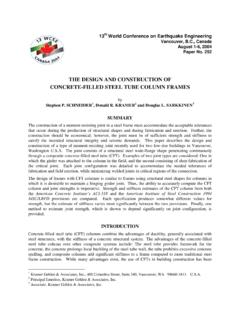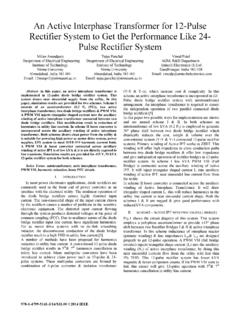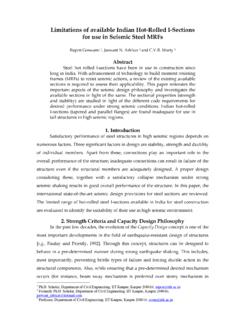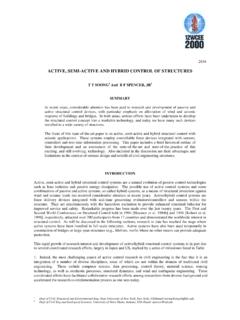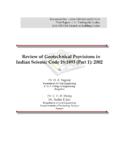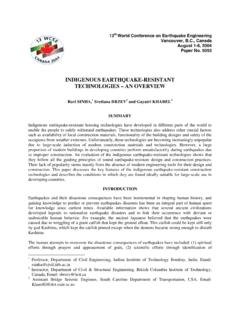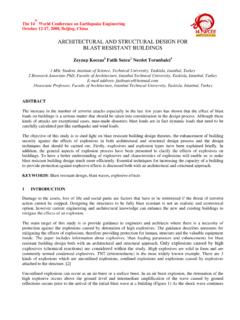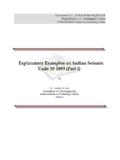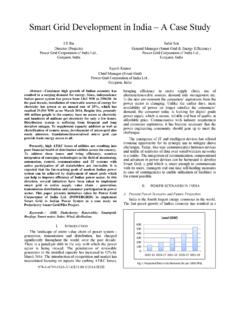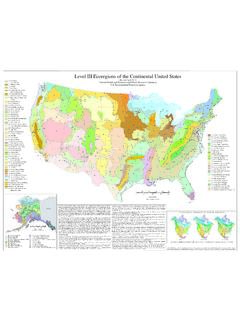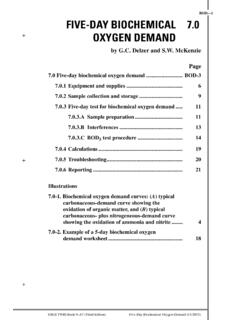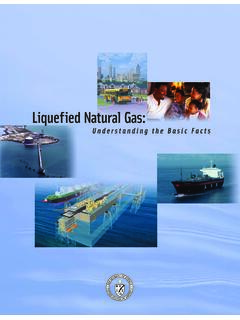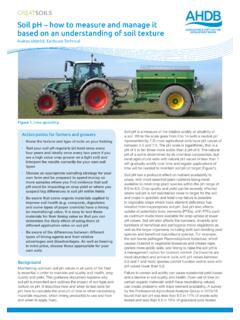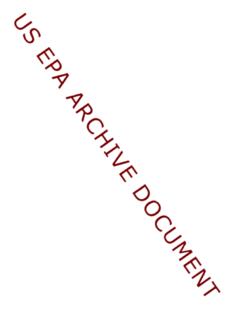Transcription of IS 2386-1 (1963): Methods of Test for Aggregates for ...
1 Disclosure to Promote the Right To InformationWhereas the Parliament of India has set out to provide a practical regime of right to information for citizens to secure access to information under the control of public authorities, in order to promote transparency and accountability in the working of every public authority, and whereas the attached publication of the Bureau of Indian Standards is of particular interest to the public, particularly disadvantaged communities and those engaged in the pursuit of education and knowledge, the attached public safety standard is made available to promote the timely dissemination of this information in an accurate manner to the public. ! $ ' + - Satyanarayan Gangaram Pitroda Invent a New India Using Knowledge 0 1 ' 5 Jawaharlal Nehru Step Out From the Old to the New 1 + , 1 + Mazdoor Kisan Shakti Sangathan The Right to Information, The Right to Live ! > 0 B Bhart hari N ti atakam Knowledge is such a treasure which cannot be stolen Invent a New India Using Knowledge IS 2386-1 (1963): Methods of Test for Aggregates forConcrete, Part I: Particle Size and Shape [CED 2: Cementand Concrete]IS : 2386 ( Part I) - 1963 Indian Standard Methods OF TEST FOR Aggregates FOR CONCRETE PART I PARTICLE SIZE AND SHAPE ( Elcvcrl~ll Reprint AUGUST 1997 ) UDC co&r@ I963 Cr 5 BUREAU OF INDIAN STANDARDS MANAK BHAVAN, 9 BAHADUR SHAH ZAFAR MARG NEW DELHI 110002 October I963 hdiun Methods Aggregates IS : 2386 ( Part I) - 1963 Standard OF TEST FOR FOR CONCRETE PART I PARTICLE SIZE AND SHAPE Cement and Concrete Sectional Committee, BDC 2 Chairman SHR~ K.
2 K. NAMBIAR Members Representing The Concrete Association of India, Bombay SHRI K. V. THADANEY ( Alternate to Shri K. K. Nambiar ) Sam K. F. ANTIA M. N. Dastur & Co. Private Ltd., Calcutta SHRI P. 8. BHATNAOAR Bhskra Dam Designs Directorate, New Delhi DR. I. C. DOS M. PAIS CWDDOU Central Water & Power Commission ( Ministry of Irrigation & Power ) SHRI Y. K. MURTHY ( ,4 Zternate ) SHRI N. D. DAFTARY Khira Steel Works Private Ltd., Bombay SHRI N. G. DEWAN Central Public Works Department SUPERINTENDING ENGINEER, END CIRCLE ( Alternate) DR. R. R. HATTIANGADI SHXI V. N. PAI ( AZternate ) SHRI P. C. HAZRA JOINT DIRECTOR STANDARDS (B&S) ASSISTANT DIRECTOR STAND- ARDS ( B&S ) ( , &?7 Late ) SHRI S. B. JOSHI SHRI M. M. LAL SHRI B. N. MAJUMDAR SHRI P. L. DAS ( Alternate ) PROF. S. R. MEHRA Central Road Research Institute ( CSIR ), New Delhi SHRI N. H. MOHILE The Concrete Association of Indis, Bombay SHRI S. N. MUKERJI Government Test House, Calcutta SHRI N. C. SEN GUPTA ( Alternate ) SHRI ERACH A.
3 NADIRSHAH Institution of Engineers ( India ), Calcutta SHRI C. B. PATEL National Buildings Organisation ( Ministry of Works, Housing & Rehabilitation ) SHRI RABINDER~INGH (Alternate) PROF. G. S. RAMASWAMY CeS;toro\euilding Research Institute ( CSIR ), The Associated Cement Companies Ltd., Bombay Geological Survey of India, Calcutta Research, Designs & Standards Organization ( Ministry of Railways ) S. B. Joshi & Co. Private Ltd., Bombay b U. P. Government Cement Factory, Churk Directorate General of Supplies t Disposals ( Ministry of Economic & Defence Co-ordination ) SHRI K. SIVA PBA~AD ( Alternate ) ( Continued m page 2 ) BUREAU OF INDIAN STANDARDS MANAK BHAVAN, 9 BAHADUR SHAH ZAFAR MARC NEW DELHI 110002 IS : 2386 ( Part I ) - 1963 ( Continued from page 1) Members Representing SHRI T. N. S. RAO Gammon Indi8 Ltd., Bombay SHRI S,. R. PINHEIRO ( Allemnte ) REPRESENTATIVE Martin Burn Ltd., Calcutta SERI NIHAR CHANDRA ROY Dalmia Cement ( Bharat ) Ltd., Calcutta SECRETARY Central Board of Irrigation & Power ( Ministry of Irrigation & Power ) BRIQ G.
4 S. SIHOTA Engineer-in-Chief s Branch. Army Headquarters SHRI R. S. MEHANDRU ( Alfernnte ) DR. BB. SUBBARAJU Indian Roads Congress, New Delhi SRRI J. M. TREHAN Roads Wing, Ministry of Transport, & Commu- nicet,inns SHRI N. H. KESWANI ( AZt~r?aafe ) DR. H. C. VISVESVARAYA, Director, IS1 ( Ez-o$cio Mwuber ) Deputy Dirertor ( Rldg ) Secretuw SHHI A. P~IT&I RAJ Extra Assistant Director ( Bldg ), IS1 Concrete Srlbcommittee, BDC 2 : 2 Convener SHRI S. B. JOSHI Members ASSISTANT DIRECTOR STANDARDS [B&S\ \--~-I SERI N. H. BHAGWANANI DR. I. C. DOS 111. PAIS CUDDOU Joshi & Co. Privrtte Ltd., Bomh8y Research, Designs & Strtndards Organization t Ministrv of Rrtilwavs 1 EAgineer-&-Chief s B&&h, Army Headquarters Central Water & Power Commission ( Ministry of Irrigation & Power ) , SHRI Y. K. MURTRY ( Alternase 1 SHRI P. L. DAS Directoreta General of Supplies & Disposals ( Ministry of Economic & Defence Co-ordination ) SHRI B. N. MAJUMDAR ( Alternate ) DIRECTOR Engineering Research Laboratory, Hyderabed SHRI V.)]
5 N. GUNAJI Maharashtra Public Works Departmeno SHRI M. A. HAF~EZ National Buildings Organisation ( Ministry of Works, Housing & Rehabilitation ) SRRI B. S. SHIVAMURTHY ( Allewmte ) SRRI C. L. HANDA Central Water & Power Commission ( Ministry of Irrigation & Power ) SRRI P. C. HAZRA Geological Survey of India, Ctllcutta SERI K. K. NAMBIAR The Concrete Association of India, Bombay SHRI 6. L. N. IYENGAR ( Alternate ) DR. M. L. PURI Central Road Research Institute ( CSIR ), New Delhi PROF. G. S. RAMASWAMY Central Building Research Institute ( CSIR ), Roorkae SHRI K. SIVA PRASAD ( Alternate ) SI~RI T. N. S. RAO Gammon India Ltd., Bombay SHRI S. R. PINHEIBO ( Allemde ) SUPERINTENDINQ ENQINEEB, Central Public Works Department END CIRCLE SHRI 0. P. GOEL ( Alternate ) SHRI J. M. TREHAN Roads Wing, Ministry of Transport & Communi- cations SZIRI R. P. SIKKA ( Alternate ) SHRI H. T. YAN Breithwaite Burn & Jessop Construction Co. Ltd., Calcutta IS : 2386 ( Part I ) - 1963 Indian Standard Methods OF TEST FOR Aggregates FOR CONCRETE PART I PARTICLE SIZE AND SHAPE 0.
6 FOREWORD This Indian Standard (&rt I) was adopted by the Indian Standards Institution on 22 August 1963, after the draft finalized by the Cement and Concrete Sectional Committee had been approved by the Building Division Council. One of the major contributing factors to the quality of concrete is the quality of Aggregates used therein. The test Methods given in this standard are intended to assist in assessing the quality of Aggregates . In a given situation, for a particular aggregate, it may not be necessary to assess all the qualities and therefore it is necessary to determine before- hand the purpose for which a concrete is being used and the qualities of the aggregate which require to be assessed. Accordingly, the relevant test Methods may be chosen from amongst the various tests covered in this standard. For the convenience of the users, the test Methods are grouped into the following eight parts of Indian Standard Methods of Test for Aggregates for Concrete ( IS : 2386-1963 ): Part I Part II Part III Part IV Part V Part VI Part VII Part VIII Particle Size and Shape Estimation of DeIeterious Materials and Organic Impurities Specific Gravity, Density, Voids, Absorption and Bulking Mechanical Properties Soundness Measuring Mortar Making Properties of Fine Aggreg: _ : Alkali Aggregate Reactivity Petrographic Examination The Sectional Committee responsible for the preparation of this standard has taken into consideration the views of the concrete special- ists, testing authorities, consumers and technologists and has related the standard to the practices followed in this country.
7 Further the need for 3 . 1s : 2386 ( Part I ) - 1963 international co-ordination among standards prevailing in different countries of the world has also beenrecognized. These considerations led the Sectional Committee to derive assistance from the published standards ~ancl publications of the following organizations: British Standards Institution American Society for Testing and Materials Wherever a reference to any Indian Standard appears in these Methods , it shall be taken as a reference to its latest version. For the purpose of deciding whether a particular requirement of this standard is complied with, the final value, observed or calculated, expres- sing the result of a test or analysis, shall be rounded off in accordance with IS : 2-1960 Rules for Rounding Off Numerical Values ( Revised). The number of significant places retained in the rounded off value should be the same as that of the specified value in this standard. This standard is intended chieily to cover the technical provisions relating to testing of Aggregates for concrete, and it does not cover all the necessary provisions of a contract.
8 1. SCOPE This standard ( Part I ) covers the following tests for Aggregates for concrete: 4 b) C) 4 e> Sieve analysis, Determination of materials finer than 75-micron, Determination of flakiness index, Determination of elongation index, and Determination of angularity number. 2. SIEVE ANALYSIS Object - This method covers the procedure for the determination of particle size distribution of fine, coarse and all-in- Aggregates by sieving or screening. Apparatus Sieves - Sieves of the sizes given in Table I, conforming to IS : 460-1962 Specification for Test Sieves ( Revised) shall be used. 4 IS : 2386 ( Part I ) - 1963 ! L TABLE I IS SIEVES FOR SIEVE ANALYSIS OF Aggregates FOR CONCRETE ( Clause ) TYPE Square hole, perforated plate Fine mesh, wire cloth DESIGNATIONS 80-mm, 63-mm, 50-mm, 40-mm, 31*5-mm, 25-mm, 20-mm, 16-mm, 12 5-mm, lo-mm, 6*3-mm, 4*75-mm 3*35-mm, 2*36-mm, l l%mm, , 300-micron, 150-micron, 75-micron Balance - The balance or scale shall be such that it is readable and accurate to percent of the weight of the test sample.
9 Sample - The weight of sample available shall be not less than the weight given in Table II. The sample for sieving ( see Table II ) shall be prepared from the larger sample either by quartering or by means of a sample divider, TABLE II MINIMUM WEIGHTS FOR SAMPLING MAXIMUM SIZE PRESENT MINIMUM Werc~rr~ OF IN SUBSTANTIAT. SAMPLE DESPAT~~IIEI) PROP~RTIOX~ FOE TEwITc II? m 63 50 40 25 20 16 12% kg 100 100 30 5U 23 12 6 3 Test Prodedure for Coarse and Fine Aggregate The sample shall be brought to an air-dry condition before weighing and sieving. This may be achieved either by drying at room temperature or by heating at a temperature of 100 to 110 C. The air-dr) sample shall be weighed and sieved successively on the appropri;tte sieves starting with the largest. Care shall be taken tocnsurc that the sieves are clean before use. IS : 2386 ( Part I ) - 1963 Each sieve shall be shaken separately over a clean tray until not more than a trace passes, but in any case for a period of not less than two minutes.
10 The shaking shall be done with a varied motion, back- wards and forwards, left to right, circular clockwise and anti-clockwise, and with frequent jarring, so that the material is kept moving over the .sieve surface in frequently changing dirkctions. Material shall not be forced through the sieve by hand pressure, but on sieves coarser than 20 mm, placing of particles is permitted. Lumps of fine material, if present, may be broken by gentle pressure with fingers against the side of the sieve. Light brushing with a soft brush on the under side of the sieve may be used to clear the sieve openings. Light brushing with a fine camel hair brush may be used on the 150-micron and 75-micron IS Sieves to prevent aggregation of powder and blinding of apertures. Stiff or worn out brushes shall not be used for this purpose and pressure shall not be applied to the surface of the sieve to force particles through the mesh. i On completion of sieving, the material retained on each sieve, together with any material cleaned from the mesh, shall be weighed.

